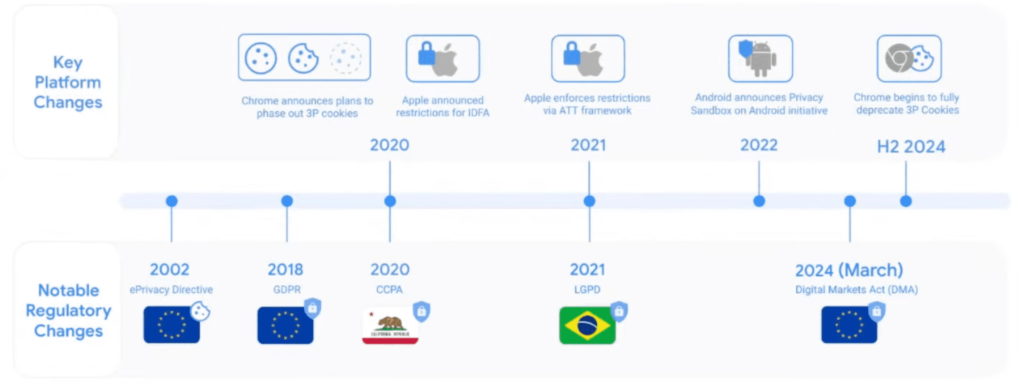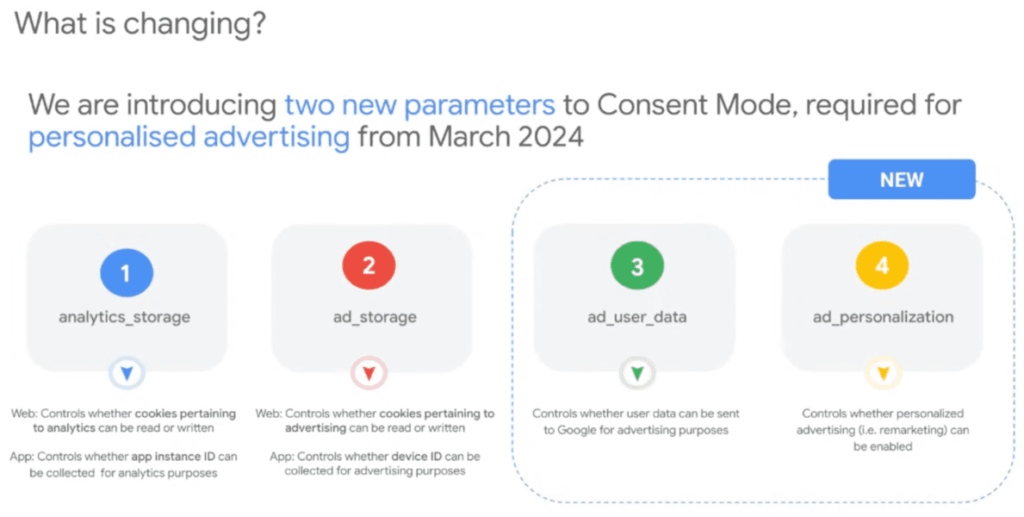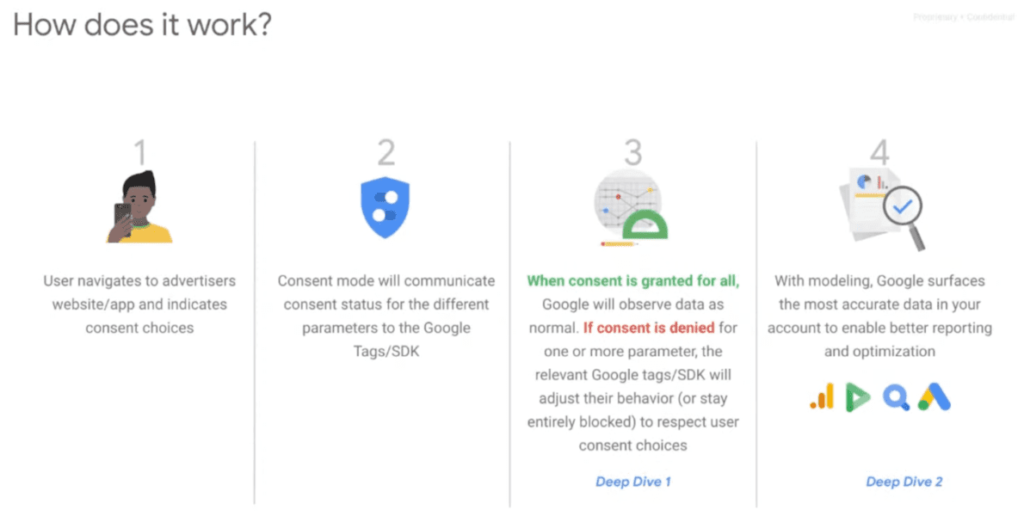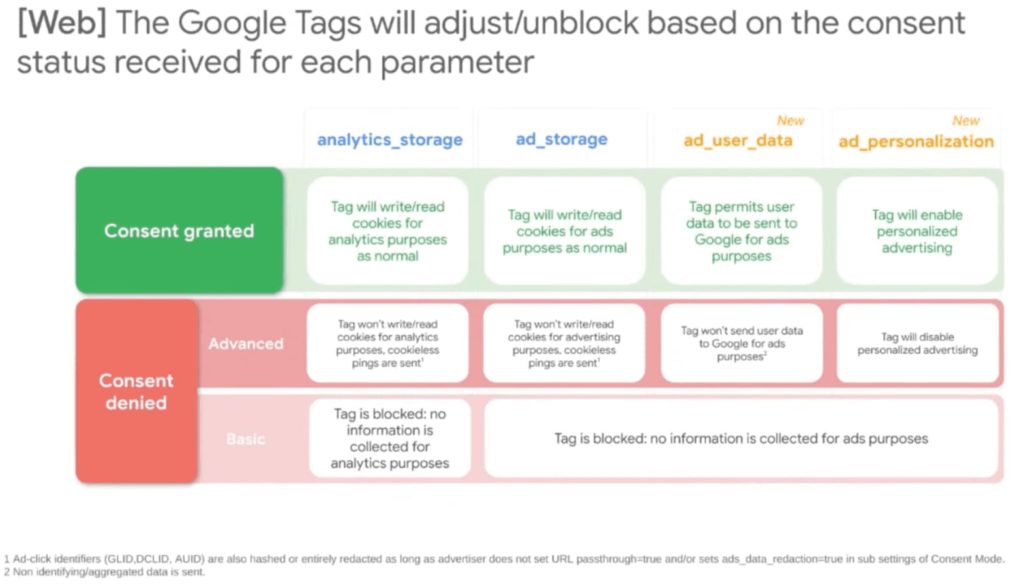In response to the new requirements of the European Digital Markets Act (DMA), which came into effect on May 2, 2023, Google has had to strengthen its commitment to data protection.
Shirin Eghtesadi, director and product lead at Google, announced on January 18, 2024, in an article published on the Google Ads Help page, new obligations for third parties using the advertising tools of the search engine, such as Google Ads, Google Analytics, and Google Marketing Platform.
From now on, advertisers who would like to continue using Google’s advertising services in Europe will need to obtain valid consent from the end user and inform Google.
In this article, we will look at all the changes that this announcement from Google will bring: who are the actors involved, how does this new model work, and how can it be configured? Ultimately, what will be the real consequences of this change for the future of online advertising on Google?
On November 28, 2023, Google hosted a webinar to unveil the major updates made to Google Consent Mode.
Replay link: Consent Mode Deep Dive for Web & App: Power Durable Performance in 2024
quick access
Context Change: Introduction of the Digital Markets Act (DMA)
The Digital Markets Act (DMA) of the European Union aims to regulate the influence of major digital platforms, designating them as “gatekeepers” to ensure fair competition and the protection of users’ personal data.
With the introduction of this regulation, which will come into effect on March 6, 2024, Google has responded by launching Consent Mode version 2 (v2) at the end of November 2023. This update, succeeding the initial version of September 2020, enables Google and its advertisers to comply with the DMA’s requirements regarding user consent.
For advertisers, this evolution represents a necessity to adapt their advertising strategies to a more regulated and transparent digital environment.

Implications of the DMA and Consent Mode v2 for Stakeholders
Who are the actors concerned by the DMA and Google's Consent Mode v2?
The DMA (Digital Markets Act) concerns all companies whose end users are located in the countries of the EEA (European Economic Area), in other words, the 27 countries of the European Union.
As for the Consent Mode V2, it applies to advertisers on web and mobile applications who use Google tools (Google Ads, Google Analytics, Search Ads 360, etc.) and whose users are located in the EEA.
In the end, the arrival of Consent Mode v2 will affect all actors and users of Google’s tools.
How does Google define an advertiser?
Google defines an advertiser as a company or individual who promotes its services, products, brands, and websites through its advertising platforms, such as Google Ads.
Advertisers conducting campaigns on Google’s advertising and analytics platforms will need to comply with the new requirements of Google’s consent management platforms (CMPs) by March 2024.
What is Consent Mode, and what are the new features of V2?
Google’s Consent Mode v2 represents a significant advancement over its initial version. Initially, this mode allowed data collection and user profiling, even without their explicit consent. However, Google has since revised its approach, aligning with higher standards of privacy compliance, thanks in part to its CMP partnership program. This mode is now an essential signaling mechanism that adjusts the use of Google services based on user consent.
Particularly in the use of Google Tag Manager, Google Analytics, and Google Ads, Consent Mode optimizes acceptance rates while allowing the collection of essential data, such as conversions, even in the absence of consent for certain uses.
With the introduction of version 2, Google enhances Consent Mode with features such as ad_user_data and ad_personalization. These new settings adjust access and use of personal data, as well as the customization of advertisements, strictly based on user consent.

Consent Mode v2: how does it operate?
How does Google Consent Mode v2 work?
Consent Mode v2 is a key element for complying with the Digital Markets Act (DMA) by obtaining user consent before processing their data on various Google platforms. Here’s how it works:
- Consent Collection: It all begins with retrieving user consent via a banner, a practice already common for many sites using consent management platforms (CMPs).
- Transmission of Consent Signals: The novelty of Consent Mode v2 lies in its ability to directly communicate these consent signals to Google’s analytics and advertising tools, thus integrating an additional step into the existing process.
- Tag Activation Based on Consent: Tags can trigger or not trigger depending on the consent given, allowing for finer management of collected data.

Key Parameters of Google Consent Mode v2
Google Consent Mode v2 operates through the integration of four essential parameters, applicable to both websites and mobile applications (via tags and SDK):
- Analytics Storage: This parameter manages the storage of information necessary for audience measurement.
- Ad Storage: It handles the storage of information dedicated to advertising.
- Ad Personalization: A novelty of v2, this parameter allows defining user consent for personalized advertising.
- Ad User Data: Another innovation of v2, it defines user consent for data sharing with Google for advertising targeting.
The consent banner plays a central role in this system, being responsible for collecting user consent choices. Before consent is granted or in case of refusal, two configurations are possible:
- Basic Consent Mode: No tags are activated, and no data is collected, viewed, or shared.
- Advanced Consent Mode: Tags are not activated, but some anonymized and functional information is sent to Google’s tools (such as browser, URL, and date) for use in conversion modeling.
In both scenarios, the consent status is communicated and integrated by Google’s tools.
When consent is given, user preferences are transmitted to the appropriate Google tools, thus enabling the activation of data collection by the relevant tags.

Consequences of Not Using Google Consent Mode v2
The exact consequences for advertisers, who have not configured consent mode v2, remain to be defined. Initially, it appears that this could limit certain functionalities on Google’s advertising platforms, such as audience targeting, retargeting, and performance measurement. Google’s documentation on this matter is still evolving.
An important point to note concerns Google Analytics. Unlike other audience analysis tools, Google Analytics explicitly requires consent to be used in several countries. Therefore, Consent Mode v2 becomes mandatory for the use of Google Analytics, emphasizing the importance of this update to ensure compliance with regulatory standards.
How to Implement Google Consent Mode v2?
Implementing Google Consent Mode v2 is a crucial step for users of Google tools and must be completed before March 6, 2024.
Initially, it is essential to implement a custom cookie banner or use a third-party consent management platform (CMP) to collect and manage the various levels of user consent required by Google Consent Mode v2. List of Google CMP Partners: CMP Partner Program
Here’s how to configure this feature, offering different methods tailored to various levels of technical expertise:
- Using Google Tag Manager: This method is recommended for those seeking a less technical and more intuitive solution. Google Tag Manager facilitates the integration and management of Consent Mode v2, allowing for simplified installation without requiring direct modifications to the site’s code.
- Manual installation with Gtag.js: For those with web development skills, manual installation via the Gtag.js script offers increased flexibility. This approach requires adding or modifying JavaScript code on your site to integrate Consent Mode v2, allowing for more advanced customization according to the specific needs of each site.
These options provide flexibility to adapt to different web environments and levels of expertise, ensuring that Consent Mode v2 can be effectively integrated to meet regulatory requirements while supporting advertising and data analysis practices.
Here is a selection of documentation designed to facilitate the deployment of Google Consent Mode v2:
GOOGLE documentation:
Cookiebot documentation, CMP recommended by Keyweo:












